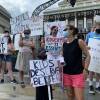Members of Boston’s City Council heard hours of testimony Wednesday evening from Boston Public Schools teachers, nurses, bus drivers and parents — mostly critical of the school district's plans for reopening the city's schools this September.
And some Council members lent their own voices to those critiques, firing questions at Superintendent Brenda Cassellius on everything from plans for testing to busing to thresholds for re-closing schools in the event of an outbreak of COVID-19.
A draft plan released by BPS last week offered two scenarios — one all-remote model, and another hybrid or "hopscotch" model, in which some students would return to classes part-time.
Members of the Boston Teachers Union have said for weeks that the district isn't ready to keep students and teachers safe.
Speaking during the Council hearing, BTU President Jessica Tang reiterated some of those points, saying that while the BTU is talking with school officials the district failed to initially include teachers and other school professionals in much of its planning process — and that the current plan leaves teachers largely on their own to navigate both the health and educational challenges posed by in-school instruction amidst a pandemic.
“We absolutely want to go back to our school buildings, and we absolutely want to teach in person,” said Tang, “But it has to be safe.”
Those points were amplified by other BTU members who testified.
Jonathan Haines, a registered school nurse, cited a litany of what he called inadequate preparations.
Many BPS classroom windows cannot be opened, Haines noted, adding that a recent announcement that classrooms will have at least one window that can open will not ensure proper ventilation.
And the district lacks a coherent plan for testing, Haines said, noting schools do not have access to rapid-result testing that can diagnose possible COVID-19 infections within 24 hours.
Haines said that for him, urging the district to hold off on in-classroom learning was a matter of ethics.
“If we do not have safe, accurate rapid testing to confirm cases in a timely manner and yet we open schools, we will spread the disease,” Haines said. “And we will spread the disease into the communities that have already been hit hardest by COVID.”
Cassellius, who stayed for some four hours of testimony and questions from Council members, reiterated that the district has not made a final decision on how schools will reopen at the start of the school year. She also defended the district’s plan to allow in-classroom learning as long as the city’s overall rate for positive COVID-19 tests remains in the low single-digits, repeating throughout the hearing that the district’s decisions will be based on science.
Current guidance from federal and state officials, Cassellius said, indicates that current COVID-19 infection numbers in Boston are low enough to meet the criteria for reopening schools.
But “if the science [says] it’s not possible” to safely reopen, she added, “we will shift to a remote-only option.”
Cassellius drew fire from several Council members who have been openly critical of the Walsh administration’s handling of school reopening plans in recent weeks.
Councilor Ricardo Arroyo, a co-sponsor of the hearing, noted that while infection rates may be low in Boston overall, data shows significantly higher rates in specific neighborhoods, especially neighborhoods with more residents of color, like East Boston, Hyde Park, Dorchester and Roxbury.
Meanwhile, Arroyo said, a lack of mandatory testing means schools will have no way to prevent outbreaks.
“There’s no way that we’re going to catch asymptomatic carriers. This plan has nothing [to address] testing for asymptomatic students,” an audibly frustrated Arroyo said. “I understand the needs that we have right now, for parents and families. ... I also understand that needs don’t make plans safer.”
Councilor Michelle Wu, who last week released a letter to city and district officials, itemizing a list of critiques and perceived flaws in the draft “hybrid” reopening model, voiced exasperation with what she characterized as a failure by BPS leadership to acknowledge many uncertainties still hanging over the plan.
“We cannot leave it that the decision is that we’re going to wait until a week before school and see what color we are,” Wu said, referring to a new, color-coded map of COVID infection rates by municipality, released by Gov. Charlie Baker earlier this week, in which communities appear in green, yellow or red based on positive test rates (and in which Boston appeared as “yellow” Wednesday).
“We know right now that we will not be green,” Wu said.
Other Council members also prodded Cassellius on other perceived deficits in the draft plan.
Councilor Andrea Campbell asked Cassellius about plans for child care for working parents who cannot stay home with students during the day.
“I’ll get back to you on child care,” Cassellius answered.
Councilor Julia Mejia asked if the draft plan, released last week, had been translated into languages other than English.
The plan “is being translated,” Cassellius replied.
Arroyo, Campbell and Wu have called on the district to take the hybrid re-opening model off the table, for now at least, and to announce and prepare for an all-remote instruction plan as soon as possible.





